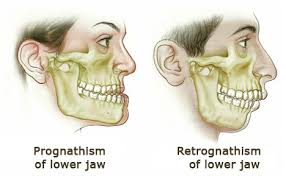 Prognathism, is a positional relationship of the mandible or maxilla to the skeletal base where either of the jaws protrudes beyond a predetermined imaginary line in the coronal plane of the skull.
Prognathism, is a positional relationship of the mandible or maxilla to the skeletal base where either of the jaws protrudes beyond a predetermined imaginary line in the coronal plane of the skull.
It is assessed clinically or radiographically.
Prognathism can result in malocclusion, in which an individual’s top teeth and lower teeth do not align properly.
Frequency in Children: 0.5 to 2.0% and
Adults: 2.0 to 4.0%.
Prognathism occurs due to normal variation among phenotypes.
Where prognathism is not the norm, it may be a malformation, the result of injury, a disease state or a hereditary condition.
It is considered a disorder only if it affects chewing, speech or social function as a byproduct of severely affected facial appearance.
Soft tissue analyses assess; nasolabial angle, the relationship of the soft tissue portion of the chin to the nose, and the relationship between the upper and lower lips, and the dental arch relationship.
Cephalometric analysis determines all types of prognathism, as it includes assessments of skeletal base, occlusal plane angulation, facial height, soft tissue assessment and anterior dental angulation.
Cephalometric radiograph allow the determination of dental and skeletal relationships and determine a treatment plan.
Prognathism affects the middle third of the face, causing it to jut out, thereby increasing the facial area, similar to the phenotype of archaic hominids and other apes.
Mandibular prognathism is a protrusion of the mandible, affecting the lower third of the face.
Alveolar prognathism is a protrusion of that portion of the maxilla where the teeth are located, in the dental lining of the upper jaw.
Prognathism is used to describe ways that the maxillary and mandibular dental arches relate to one another, including malocclusion.
With maxillary or alveolar prognathism there is an alignment of the maxillary incisors significantly anterior to the lower teeth, the condition is called an overjet.
When the reverse is the case, and the lower jaw extends forward beyond the upper, the condition is referred to as retrognathia or reverse overjet.
Alveolar prognathism, is caused by thumb sucking and tongue thrusting, causing teeth to misalign.
Functional appliances can be used in growing children to help modify bad habits and neuro-muscular function.
Alveolar prognathism can be corrected with fixed orthodontic therapy.
Maxillary prognathism or more accurately, retrognathism, there is a lack of growth of the mandible.
Prognathism,can be treated in growing patients with orthodontic functional or orthopaedic appliances.
In adult patients this condition can be treated with a combined surgical/orthodontic treatment: most of the time a mandibular advancement is performed.
Mandibular prognathism is a potentially disfiguring genetic disorder where the lower jaw outgrows the upper, resulting in an extended chin and a crossbite.
It can be the result of inbreeding.
The best known historical example is Habsburg jaw, due to its prevalence in members of the House of Habsburg.
Most cases are considered polygenic,
but possibly transmitted through an autosomal recessive type of inheritance.
Treatment for mandibular prognathism is a combination of orthodontics and orthognathic surgery.
The orthodontics can involve braces, removal of teeth, or a mouthguard.
